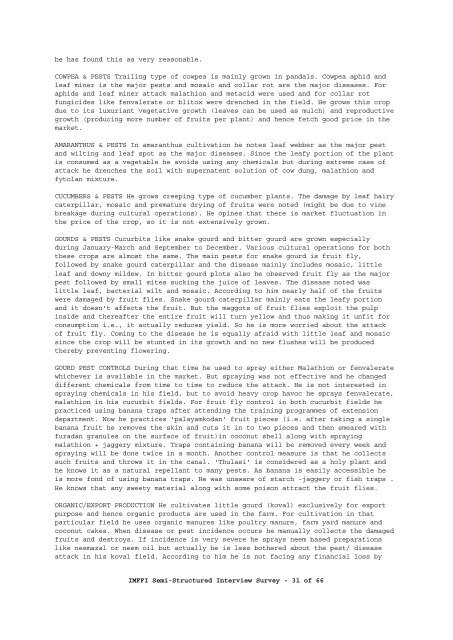“Key Informant Survey” of Production, Value, Losses and ... - DfID
“Key Informant Survey” of Production, Value, Losses and ... - DfID
“Key Informant Survey” of Production, Value, Losses and ... - DfID
You also want an ePaper? Increase the reach of your titles
YUMPU automatically turns print PDFs into web optimized ePapers that Google loves.
he has found this as very reasonable.<br />
COWPEA & PESTS Trailing type <strong>of</strong> cowpea is mainly grown in p<strong>and</strong>als. Cowpea aphid <strong>and</strong><br />
leaf miner is the major pests <strong>and</strong> mosaic <strong>and</strong> collar rot are the major diseases. For<br />
aphids <strong>and</strong> leaf miner attack malathion <strong>and</strong> metacid were used <strong>and</strong> for collar rot<br />
fungicides like fenvalerate or blitox were drenched in the field. He grows this crop<br />
due to its luxuriant vegetative growth (leaves can be used as mulch) <strong>and</strong> reproductive<br />
growth (producing more number <strong>of</strong> fruits per plant) <strong>and</strong> hence fetch good price in the<br />
market.<br />
AMARANTHUS & PESTS In amaranthus cultivation he notes leaf webber as the major pest<br />
<strong>and</strong> wilting <strong>and</strong> leaf spot as the major diseases. Since the leafy portion <strong>of</strong> the plant<br />
is consumed as a vegetable he avoids using any chemicals but during extreme case <strong>of</strong><br />
attack he drenches the soil with supernatent solution <strong>of</strong> cow dung, malathion <strong>and</strong><br />
fytolan mixture.<br />
CUCUMBERS & PESTS He grows creeping type <strong>of</strong> cucumber plants. The damage by leaf hairy<br />
caterpillar, mosaic <strong>and</strong> premature drying <strong>of</strong> fruits were noted (might be due to vine<br />
breakage during cultural operations). He opines that there is market fluctuation in<br />
the price <strong>of</strong> the crop, so it is not extensively grown.<br />
GOURDS & PESTS Cucurbits like snake gourd <strong>and</strong> bitter gourd are grown especially<br />
during January-March <strong>and</strong> September to December. Various cultural operations for both<br />
these crops are almost the same. The main pests for snake gourd is fruit fly,<br />
followed by snake gourd caterpillar <strong>and</strong> the disease mainly includes mosaic, little<br />
leaf <strong>and</strong> downy mildew. In bitter gourd plots also he observed fruit fly as the major<br />
pest followed by small mites sucking the juice <strong>of</strong> leaves. The disease noted was<br />
little leaf, bacterial wilt <strong>and</strong> mosaic. According to him nearly half <strong>of</strong> the fruits<br />
were damaged by fruit flies. Snake gourd caterpillar mainly eats the leafy portion<br />
<strong>and</strong> it doesn't affects the fruit. But the maggots <strong>of</strong> fruit flies exploit the pulp<br />
inside <strong>and</strong> thereafter the entire fruit will turn yellow <strong>and</strong> thus making it unfit for<br />
consumption i.e., it actually reduces yield. So he is more worried about the attack<br />
<strong>of</strong> fruit fly. Coming to the disease he is equally afraid with little leaf <strong>and</strong> mosaic<br />
since the crop will be stunted in its growth <strong>and</strong> no new flushes will be produced<br />
thereby preventing flowering.<br />
GOURD PEST CONTROLS During that time he used to spray either Malathion or fenvalerate<br />
whichever is available in the market. But spraying was not effective <strong>and</strong> he changed<br />
different chemicals from time to time to reduce the attack. He is not interested in<br />
spraying chemicals in his field, but to avoid heavy crop havoc he sprays fenvalerate,<br />
malathion in his cucurbit fields. For fruit fly control in both cucurbit fields he<br />
practiced using banana traps after attending the training programmes <strong>of</strong> extension<br />
department. Now he practices 'palayamkodan' fruit pieces (i.e. after taking a single<br />
banana fruit he removes the skin <strong>and</strong> cuts it in to two pieces <strong>and</strong> then smeared with<br />
furadan granules on the surface <strong>of</strong> fruit)in coconut shell along with spraying<br />
malathion + jaggery mixture. Traps containing banana will be removed every week <strong>and</strong><br />
spraying will be done twice in a month. Another control measure is that he collects<br />
such fruits <strong>and</strong> throws it in the canal. 'Thulasi' is considered as a holy plant <strong>and</strong><br />
he knows it as a natural repellant to many pests. As banana is easily accessible he<br />
is more fond <strong>of</strong> using banana traps. He was unaware <strong>of</strong> starch -jaggery or fish traps .<br />
He knows that any sweety material along with some poison attract the fruit flies.<br />
ORGANIC/EXPORT PRODUCTION He cultivates little gourd (koval) exclusively for export<br />
purpose <strong>and</strong> hence organic products are used in the farm. For cultivation in that<br />
particular field he uses organic manures like poultry manure, farm yard manure <strong>and</strong><br />
coconut cakes. When disease or pest incidence occurs he manually collects the damaged<br />
fruits <strong>and</strong> destroys. If incidence is very severe he sprays neem based preparations<br />
like neemazal or neem oil but actually he is less bothered about the pest/ disease<br />
attack in his koval field. According to him he is not facing any financial loss by<br />
IMFFI Semi-Structured Interview Survey - 31 <strong>of</strong> 66

















